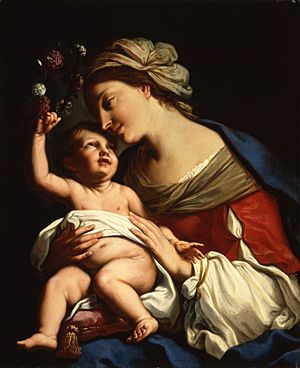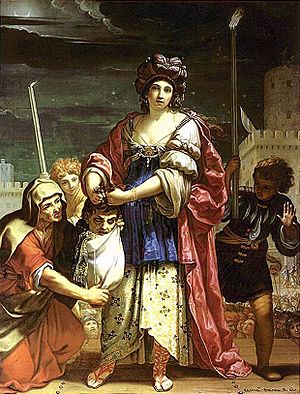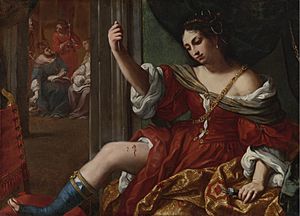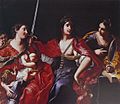Elisabetta Sirani facts for kids
Quick facts for kids
Elisabetta Sirani
|
|
|---|---|
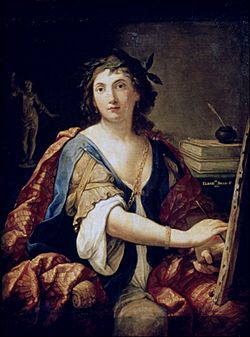
Self-Portrait as Allegory of Painting (1658) by Elisabetta Sirani, Pushkin Museum, Moscow
|
|
| Born | 8 January 1638 |
| Died | 28 August 1665 (aged 27) Bologna, Holy Roman Empire
|
| Nationality | Italian |
| Education | Family |
| Known for | Painting |
| Movement | Baroque |
Elisabetta Sirani (born January 8, 1638 – died August 28, 1665) was a talented Italian Baroque painter and printmaker. She passed away at the young age of 27 under unexplained circumstances. Elisabetta was one of the first female artists in Bologna, Italy, during the early modern period. She even started a special school for other women artists.
Contents
Life of a Young Artist
Elisabetta Sirani was born in Bologna on January 8, 1638. She was the first of four children born to Margherita and Giovanni Andrea Sirani. Her father, Giovanni, was an art dealer and painter. He was part of the Bolognese School of painting and had been a favorite student of the famous artist Guido Reni. Giovanni didn't paint many works himself. Instead, he became a teacher, taking over Reni's role.
Elisabetta first learned to paint in her father's art studio. At first, her father wasn't sure about teaching his daughter. But Elisabetta quickly learned his techniques and became one of Bologna's most famous painters. An art writer named Carlo Cesare Malvasia, who knew the Sirani family, said he helped convince her father to train her.
Malvasia wrote about Elisabetta in his book, Lives of the Bolognese Painters, published in 1678. He praised her unique ideas, her drawing style, how fast she worked, and her professional attitude. He saw her as a true genius from Bologna.
To create her own painting style, Elisabetta studied the works of other artists like Annibale Carracci and Simone Cantarini. Besides learning painting techniques, she also studied Bible stories, legends of saints, and ancient Greek and Roman myths. She received her first art job when she was a teenager. It was a painting called Baptism of Christ. She was also good at music.
Some experts believe that Elisabetta's artistic fame soon became greater than her father's and her two sisters', who were also painters. By 1654, her father, Giovanni Andrea Sirani, became ill. So, Elisabetta started managing the family's art workshop. She became the main person earning money for her family, using her teaching fees and money from her portrait paintings. Her studio was very successful. This was partly because Bologna was a city that welcomed and celebrated women artists.
Elisabetta's Sudden Death
Elisabetta Sirani died suddenly in August 1665 in Bologna. Her death was unexpected, and some people suspected she had been poisoned. A maidservant was even accused, but the charges were later dropped.
Elisabetta was given a very grand funeral. It included a huge catafalque (a decorated platform for a coffin) with a life-sized sculpture of her. There were speeches and music made in her honor by important people in Bologna. She was buried in the Basilica of San Domenico in Bologna, in the same tomb as her father's teacher, Guido Reni.
Her public funeral showed how much she was respected by people at the time. A poet called her the Lamented Paintbrush. People from all over, including important officials, mourned her. They said it was a great loss to lose such a wonderful artist in such a strange way. The fancy funeral showed how highly she was thought of, even internationally.
Elisabetta's Students
Elisabetta Sirani not only took over her father's workshop, but she was also a great teacher. She especially helped women artists grow during the Renaissance period. She trained many male and female artists, including her younger sisters, Barbara and Anna Maria. She also taught at least twelve other young women at the school she started.
This school became the first painting school for women in Europe that was not part of a convent (a religious community). It welcomed women regardless of their artistic background or social status.
Some of her students became famous artists themselves. These included Veronica Fontana, who became a well-known wood-engraver. Others like Caterina Pepoli and Maria Elena Panzacchi also had art careers in Bologna.
Famous Works
Elisabetta Sirani was an incredibly productive artist, especially since she died so young. She created over 200 paintings, 15 etchings, and hundreds of drawings. She kept careful lists and records of her paintings and who bought them, starting in 1655. Many of her paintings are also signed, which was not common for male artists at the time. She might have done this to make sure her work wasn't confused with her father's. Her signature also showed her unique artistic ideas.
Elisabetta was known for how quickly she painted. She created so many works that some people doubted she painted them all herself. To prove them wrong, she invited her accusers on May 13, 1664, to watch her paint a portrait in one sitting.
Her artworks covered many different topics. These included historical stories, Bible stories, allegories (pictures that represent ideas), and portraits. Many of her paintings featured women. Elisabetta was the first female artist in Bologna to focus on history painting (large paintings showing important events). Many of the women she trained followed her example. This was different from other female painters of her time, who usually painted still lifes (pictures of objects).
She received her first big public art job in 1657 in Bologna. She painted at least 13 large altarpieces for churches. One famous example is The Baptism of Christ from 1658. Around 1660, she started focusing on smaller religious images, especially the Virgin and Child and the Holy Family. These were very popular with private collectors.
Her customers included important people like cardinals, kings, princes, dukes, merchants, and scholars from Bologna and all over Europe. Elisabetta became a local celebrity. Visitors like diplomats and noblemen would come to her studio to watch her paint.
Elisabetta's painting style was similar to her father's teacher, Guido Reni. However, Elisabetta used stronger contrasts of light and shadow, amazing brushstrokes, and brighter colors. Her powerful paintings of female heroes, like Portia Wounding Her Thigh, are similar to the work of Artemisia Gentileschi. Elisabetta often chose less common subjects for her paintings. Her unique way of showing ideas in her art was praised by many people. Her drawings, often done quickly with pen or brush and ink, were as brilliant as her paintings.
Elisabetta was able to change how people expected women artists to paint. Instead of just doing portraits, she turned them into allegories. These paintings invited viewers to think about their deeper meaning. She often based her allegories on descriptions from a book called Iconologia. Some of her favorite topics included Greek and Roman myths and figures from mythology.
Judith and Holofernes, around 1660s
The story of Judith was a popular subject for female artists in the 1600s. Elisabetta Sirani's father also focused on history painting, so it was natural for her to paint this topic. In Sirani's version, Judith is the main figure, creating a classic, triangular shape in the painting. Judith's old maidservant helps her carry the head of Holofernes. Sirani shows Judith at night, after she has committed the act. This painting has been compared to Gentileschi's Judith Slaying Holofernes from 1620. Both paintings show Judith as a strong woman.
In other paintings of Judith and Holofernes by Sirani, Judith looks calm and gentle. Her strength comes from the act of slaying Holofernes, rather than from her face or movements. She is shown as a beautiful woman to be admired.
St. Anthony of Padua, 1662
This painting hangs in the Pinacoteca in Bologna, near works by Guido Reni. It shows the young saint, St. Anthony, kneeling as a lover of children. The heavenly children are painted with a joyful, earthly feeling that some experts say was new at the time. The way the painting is put together creates a strong diagonal line. A jeweler named Giovanni Battista Cremonese asked her to paint this work.
Portia Wounding Her Thigh, 1664
This painting is often seen as showing a strong woman. The image has a dark background. A large figure of Portia, dressed in red, holds a knife above her bleeding thigh. Many scholars see this as a picture of a strong-willed woman. According to the original story by Plutarch, Portia hurt herself to show her husband, Brutus, that she was strong enough to share his burdens and secrets. She wanted to prove her strong will to him.
Gallery


